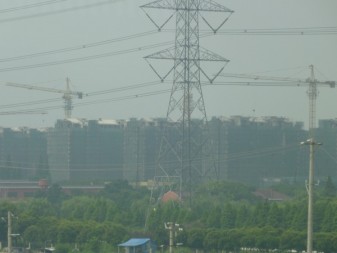That, in essence, is one of China’s biggest energy challenges today. There are millions more Chinese like Tina who are plugging in appliances typical of a Western lifestyle. This exploding consumerism -- plus the construction of new high-rises, like many in Shanghai, and new factories -- has intensified the nation’s thirst for electricity.
China’s Massive New Infrastructure Project: A New Grid
So to satisfy this soaring need, China’s main state-owned utility has launched a monumental infrastructure project to build a “strong, smart grid.”
“And the ‘strong’ really refers to the high-voltage system,” says Matt Lecar. He’s a grid expert at GE in San Francisco and a consultant to the China Electric Power Research Institute. “They've actually put a lot of investment into creating kind of a national backbone infrastructure, which is something we don't have in the U.S.”
It’s a backbone formed by building six ultra-high-voltage transmission lines crisscrossing the country. They will carry the highest alternating current in the world.
Chivas Lam, a partner at Qiming Venture Capital in Shanghai, says, “The majority of the resources -- the coal, the natural gas, the hydro -- is in the western or central part of China, while the load center is on the east coast, primarily.” That means electrons have to travel up to a thousand miles or more. “So obviously,” Lam says, “the better way is to generate the power locally rather than shipping or transporting coal and then using the electricity transmission network to transmit the power to the end user.”
And by doing so, conserve natural resources, cut pollution, shrink the country’s carbon emissions and improve energy efficiency. The new smart grid will significantly boost the use of wind and solar power to generate electricity. It’s part of China’s plan to get 11 percent of its energy from non-fossil fuels by 2015 and cut down its dependence on coal, by far its main source of power -- and of its air pollution.
Problems Integrating Renewables
But integrating China’s new wind power capacity into the grid has been problematic. Wind farm construction here has so outpaced the grid build-out that nearly a quarter of China’s turbines stand idle because they’re not yet connected to the grid.
China’s utilities ran into another huge problem last year. Tom Pellman, a policy advisor for Vestas Wind Systems in Beijing describes, “a series of large grid accidents in which a power line failure caused hundreds of wind turbines to suddenly trip off the grid and stop producing energy.” The accidents led to a major shift in planning for the grid, focusing more effort on how to make the system smarter and more resilient.
Smart Part of the Grid
“The idea of a smart grid is through more sensors, more controls downstream, to have tighter control, to be able to deliver the right energy to the right places at the right time,” says GE’s Lecar.
Among these “sensors and controls” are “smart” meters, digital electric meters that have stirred opposition in parts of California where critics allege safety and privacy problems. While U.S. utilities are aiming to install 15 million smart meters by 2015, China claims to have already deployed more than three times that many. Foreign businesses are vying for a slice of the action. This year, Bay Area-based companies, including Echelon and Glen Canyon, have formed partnerships with Chinese firms to develop more products, including smart meters, for this giant market.
China’s Race To Power
In a Beijing subway car, an old man in threadbare clothing plays a traditional Chinese stringed instrument for money as he weaves through a crowd of other Chinese, texting on their smartphones and listening to iPods. It’s a snapshot of a complex challenge in China’s race to power; millions of poor Chinese and the expanding middle class here are all part of a populace hungry for a more modern lifestyle.
China’s new “smarter, stronger” grid is scheduled to be up and running by 2020.
